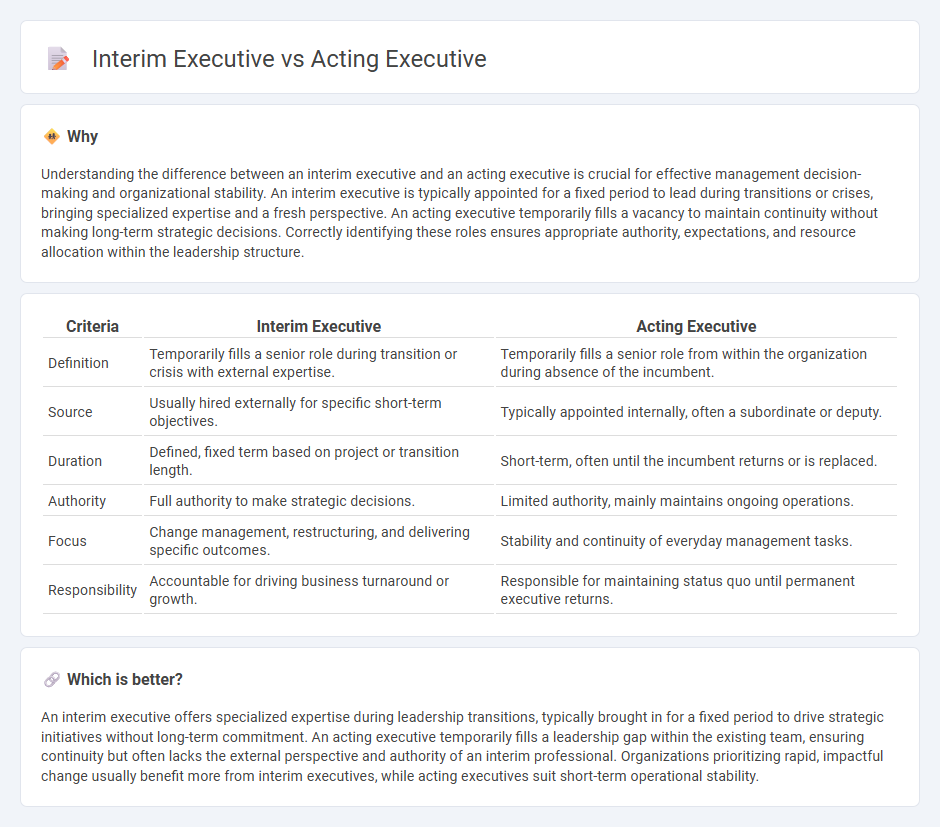
Interim executives are appointed for a predetermined period to manage transitions, typically bringing specialized expertise to stabilize or grow an organization during change. Acting executives temporarily fill a leadership role due to sudden absence or vacancy, often maintaining ongoing operations without major strategic shifts. Explore more about the roles and responsibilities that differentiate interim and acting executives in management.
Why it is important
Understanding the difference between an interim executive and an acting executive is crucial for effective management decision-making and organizational stability. An interim executive is typically appointed for a fixed period to lead during transitions or crises, bringing specialized expertise and a fresh perspective. An acting executive temporarily fills a vacancy to maintain continuity without making long-term strategic decisions. Correctly identifying these roles ensures appropriate authority, expectations, and resource allocation within the leadership structure.
Comparison Table
| Criteria | Interim Executive | Acting Executive |
|---|---|---|
| Definition | Temporarily fills a senior role during transition or crisis with external expertise. | Temporarily fills a senior role from within the organization during absence of the incumbent. |
| Source | Usually hired externally for specific short-term objectives. | Typically appointed internally, often a subordinate or deputy. |
| Duration | Defined, fixed term based on project or transition length. | Short-term, often until the incumbent returns or is replaced. |
| Authority | Full authority to make strategic decisions. | Limited authority, mainly maintains ongoing operations. |
| Focus | Change management, restructuring, and delivering specific outcomes. | Stability and continuity of everyday management tasks. |
| Responsibility | Accountable for driving business turnaround or growth. | Responsible for maintaining status quo until permanent executive returns. |
Which is better?
An interim executive offers specialized expertise during leadership transitions, typically brought in for a fixed period to drive strategic initiatives without long-term commitment. An acting executive temporarily fills a leadership gap within the existing team, ensuring continuity but often lacks the external perspective and authority of an interim professional. Organizations prioritizing rapid, impactful change usually benefit more from interim executives, while acting executives suit short-term operational stability.
Connection
Interim executives and acting executives both serve temporary leadership roles to maintain operational continuity during vacancies or transitions in management. Interim executives are often hired externally with specialized expertise to drive strategic initiatives, while acting executives typically step in from within the organization to fulfill immediate managerial duties. Both positions ensure effective decision-making and team stability until a permanent executive is appointed.
Key Terms
Authority
Acting executives possess temporary authority granted during a leader's absence, often maintaining existing policies without significant changes. Interim executives hold full decision-making power and are appointed to lead transitions, implement strategic initiatives, or address crises. Explore their distinct roles and authority levels to optimize leadership effectiveness in your organization.
Tenure
An acting executive typically serves temporarily during a short-term absence, often for a few weeks or months, maintaining continuity without long-term strategic changes. In contrast, an interim executive is appointed for a defined period, usually several months to a year or more, to lead significant transitions or implement strategic initiatives. Explore the distinctions further to determine the best fit for your organization's leadership needs.
Decision-making
Acting executives typically handle ongoing decision-making tasks during short-term absences, maintaining current strategies without major adjustments. Interim executives take a more strategic role, making critical decisions aimed at long-term improvements or transformations within an organization. Explore the key differences in decision-making approaches between acting and interim executives to understand their impact on business continuity.
Source and External Links
Fractional vs. Interim, Acting vs. Interim Executives - Acting executives are internal leaders who temporarily assume additional roles while maintaining their primary duties, providing flexibility during leadership vacancies.
What Does Acting Mean in a Job Title? - An acting executive, such as an acting CEO, is someone who temporarily fills a top role until a permanent replacement is found, often from within the organization.
Succeeding as an Acting Executive Director - Being an acting executive director involves taking on high-level responsibilities temporarily while navigating significant challenges and communicating effectively with the board.
 dowidth.com
dowidth.com